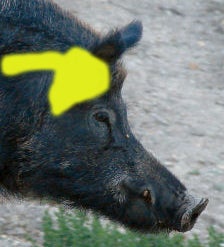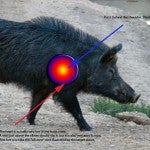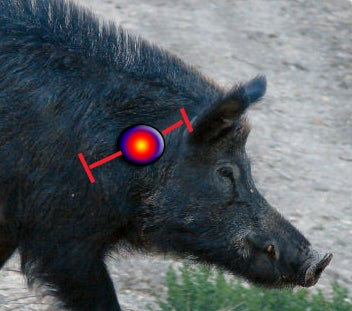This post was initiated by a comment on an old thread by Rick Pasour. Thanks, Rick, for a great question and a potentially hot topic.
Here’s what he asked:
Hi Guys- I was looking at the internal organs on a hog and looking at its bone structure with that hard fatty grisel plate over the lungs and heart. So I was wondering if you are shooting a heavy caliber rifle why not slip a bullet into the hogs brain for a humane killing shot. I know you guys and gals must be a true marksman in making such a shot.Wouldn’t this save the hams on both sides of the hog for alot more meat saved than wasted from the bullet damage?
(A lot of what I’m going to write now has been written before, both by me and by others even more skilled at explaining this. Bear with me if you already know this, and feel free to offer your own input and opinions. )
First of all, as far as I’m concerned there are only two excuses for a meat hunter to lose quality meat, especially from the hams… inexperience and impatience. There is no other reason to put a bullet into the hams or backstraps. Wait for the right shot and take it. Know what your gun and bullet will do, and put that work FOR you, rather than trying to work against it.
As far as head shots, I’ve touched on this before, but the bottom line is that the risks of such a shot far outweigh the possible benefits.
 To begin with, a hog’s brain is relatively small, especially if you’re not shooting straight down on it. From a normal shot angle, the target area is only a few inches at most (the yellow on this photo is a fairly liberal representation of the target area for a killing, brain shot). A small deviation in the shot placement can result in a horrible, maiming wound… either destroying the hog’s nose and nasal cavity, jaws, or eyes. Any of these wounds will result in a long, slow death, and will make tracking and recovery almost impossible. In short, it’s a really bad choice, despite the fact that there are many people out there who still swear by it.
To begin with, a hog’s brain is relatively small, especially if you’re not shooting straight down on it. From a normal shot angle, the target area is only a few inches at most (the yellow on this photo is a fairly liberal representation of the target area for a killing, brain shot). A small deviation in the shot placement can result in a horrible, maiming wound… either destroying the hog’s nose and nasal cavity, jaws, or eyes. Any of these wounds will result in a long, slow death, and will make tracking and recovery almost impossible. In short, it’s a really bad choice, despite the fact that there are many people out there who still swear by it.
The argument that a “good marksman should have no problem with that shot” is flawed, because it doesn’t take into account one critical fact. A target at the range is stationary, while an animal is not.
It’s not hard for a skilled marksman to put bullet after bullet into a three-inch target, even at 100 yards. The target will always be in exactly the same spot, at the same distance, and the same angle. Once a shooter has the mechanics of the shot down, it’s practically automatic. Level the sights, control your breathing, manage the trigger pull, and you’ll put the bullet right where you want it every single time.
But a living target, such as a hog, is never completely still. Animals are in constant motion, and it’s safe to say that no part of an animal’s body moves more than its head. What’s more, those movements will appear completely random to an observer, so timing the movements and the shot is not realistic. A prey animal is constantly reacting to visual, olfactory, and auditory stimuli, and all of those reactions result in head movements.
Not only does the head present a challenging, moving target, it’s also surrounded by some pretty thick bone. The skull makes the gristle-plate (the shield) look like a sheet of paper by comparison. There are weak spots on a hog’s skull, but they’re not large. In addition to the sheer strength of this bone, the sloping angles of a hog’s head make for a tricky impact surface, and can deflect the energy of a bullet strike (much like a car windshield). I know of at least two, very reliable sources who have bounced high-powered bullets off of a hog’s skull without killing the animal.
The bottom line is, much better shot options exist.
 First, the traditional “heart/lung” shot, when properly executed, is deadly and quick without extensive meat damage. If anyone saw the video of Kat’s hog, you saw the animal drop on the spot at her shot. That bullet cut the arteries at the top of the hog’s heart, and also smashed up the ends of the lungs. Meat loss was limited to about three or four inches on the off-side shoulder.
First, the traditional “heart/lung” shot, when properly executed, is deadly and quick without extensive meat damage. If anyone saw the video of Kat’s hog, you saw the animal drop on the spot at her shot. That bullet cut the arteries at the top of the hog’s heart, and also smashed up the ends of the lungs. Meat loss was limited to about three or four inches on the off-side shoulder.
Even when the heart/lung shot doesn’t make an instant kill, it seldom requires extensive trailing. Damage to the cardiopulmonary system cases death pretty much without exception, robbing the body of oxygenated blood and usually filling the lungs with blood. Life systems shut down quickly after that.
There are two key reasons why this shot is so often effective and highly recommended. First off, the heart/lung area offers a large kill zone (about 8-inches on an average sized hog), and this is the part of the animal that offers the most stationary target. Legs and head move constantly, but the chest area tends to be fairly immobile, or to make large steady movements so that it’s easier to hit.
The second reason is simple familiarization. Almost every hunter has been indoctrinated with the image and idea of the heart/lung area. The image is emblazoned onto our minds by magazine articles, hunter education materials, videos, and even hunters’ conversations. We know where this spot is, and that knowledge allows us take aim and make a shot without the second-guessing and doubts that can cause many hunters to make a bad decision. As I tell clients and newer hunters, “Just put it behind his shoulder, and give him hell.”
As far as the gristle plate, if you’re using a good bullet and sufficient caliber, you’ll kill the animal. The exception might be with a truly large, old boar. With a hog like this, the recommendation is to think like an archer. You want to hold your shot until the animal offers a quartering-away angle, and then you can place your bullet behind the last rib, angling forward into the vitals.
There is another option that I really like… the neck shot.
This one is also a bit controversial, but I think the problem is more a case of a lack of understanding of the animal’s physiology than anything else, along with some failure to understand that you have to make an educated decision when you choose your shot. The neck shot is a great choice under the right circumstances, but not so great when things aren’t ideal. That’s when you either choose not to shoot, or fall back on the heart/lung area. 
On a hog, the kill zone for a neck shot is almost as big as the heart/lung area. Put a high-powered bullet in that zone, about halfway between the base of the ear and the point of the shoulder, and it will kill the animal where it stands. You’ll sever the spinal cord, effectively shutting down the animal’s central nervous system. Vital body functions will stop almost instantly.
You will not have to track a neck-shot hog. If it runs off, it’s because you missed. There is a large margin of error on the shot. Too high, and you’ll sever the brain stem or hit the brain. Higher than that results in a miss. Too low and you’ll sever the windpipe, carotid artery, or jugular vein. Lower than that is a minor flesh wound or a clean miss.
Meat loss with a neck shot is generally minimal. You will probably lose some of the neck roasts, but that’s a small price to pay in exchange for a quick, clean kill.
NOTE: The neck shot requires a proper angle and a steady rest, however. It’s still close to the head, so if you’re not stable enough you risk hitting the jaw or nose. The solution is simple. Don’t take the shot.
And that’s the bottom line any time. If you’re not comfortable that you can put the shot right where you want it, then don’t shoot. It’s a discipline that any hunter should master, but far too few have bothered to do so. As a result, you see bad shots taken in haste or out of desperation. Something I absolutely hate to hear from any hunter is, “It was the only shot I had, so I had to take it!”
A sport hunter never has to take a shot… never! The simple fact is that none of us is going to starve if we let the animal get away.
We may be disappointed, or we may be harangued by our hunting buddies, guides, or other observers, but we are not going to go hungry. Sure, we may have spent a lot of money for a hunt, only to be faced with a do-or-die shot opportunity. It could be the trophy of a lifetime. But it is NOT a matter of life and death to us. It is, on the other hand, a matter of life and death to the animal.
We are not out there because we have to be, we are out there for sport, and it is only ethical and right that we do the best we can to make the death of any game animal as clean and humane as possible.





Phillip,
“A sportsman never has to take a shot… Never!” Truer words have never been spoken. If you can’t be sure of your shot don’t shoot; it is as simple as that.
Your pics are a great example of the location of vitals.
By way of an illustration, I’ve got a couple of events that happened to me.
I think I’m a pretty good shot. I’ve killed my fair share of hogs so I’m confident of my abilities. I was up in a low tree stand, waiting for some hogs to traipse by. When a small meat hog finally came by, I shot him once right in the head. He dropped like a bag of wet sand. By the time I climbed down though, the pig was beginning to come to. Having removed the magazine from the rifle, I slapped it back in, racked the action, and loaded another round in the chamber. I took careful aim and shot the poor fellow again, confident that the job was now done. Imagine my surprise when he kept on trying to get up. I ran over, pinned him down, and carefully put two more rounds behind his ear and immediately ended this fiasco.
Upon closer examination, and a very careful skinning, I found out what happened. The first bullet failed to penetrate, for some reason it just cratered the skull. The second shot hit right where I aimed but caromed over the skull and under the skin, and ended up three inches further back in the neck.
Neither shot was lethal, and if I had waited any longer, he would have gotten away with a couple of holes in his scalp and a splitting headache.
From then on I never used my Ruger 10/22 without first flattening the tips on the bullets. The roundnose in the standard high velocity round just slides over if the angle isn’t close to ninety degrees.
The second incident was inexplicable. Again I was sniping at a meat hog. Range was exactly a measured fifty yards. 22 Hornet with Winchester softpoints. I had that fellow dead to rights. He was broadside to me when I pulled the trigger and he dropped like a stone. Imagine my surprise (Happens a lot to me…) when I got to him, instead of the side brain shot I expected, I had a made a frontal brain shot! I don’t how or when or anything, but there it is. You just never know.
Thanks again for writing a very complete, informative and important post. We are all ambassadors of the shooting sports, let us always do the right thing!
Regards,
Albert A Rasch
The Rasch Outdoor Chronicles